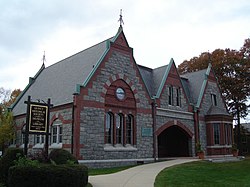Adams Academy
|
Adams Academy
|
|

Front of the Academy building
|
|
| Location | 8 Adams Street, Quincy, Massachusetts |
|---|---|
| Coordinates | 42°15′13.27″N 71°0′22.97″W / 42.2536861°N 71.0063806°WCoordinates: 42°15′13.27″N 71°0′22.97″W / 42.2536861°N 71.0063806°W |
| Built | 1869 |
| Architect | Ware & Van Brunt |
| Architectural style | Late Gothic Revival |
| NRHP Reference # | 74000379 |
| Significant dates | |
| Added to NRHP | September 6, 1974 |
| Designated NHL | April 19, 1994 |
Adams Academy was a school that opened in 1872 in Quincy, Massachusetts, United States. John Adams, the second President of the United States, had many years before established the Adams Temple and School Fund. This fund gave 160 acres (0.65 km2) of land to the people of Quincy in trust. His objective for the money was to build a school in honor of his friends John Hancock and Josiah Quincy, who, like Adams, lived in the town of Quincy, Massachusetts.
John Adams, the second President of the United States, was a lifelong resident of Quincy, Massachusetts. In 1822, when he was in his eighties, he made several bequests to the town of Quincy. One gave to the town land and funding for the construction of the First Parish Church, one concerned the disposition of part of his personal library, and the third was for the establishment of a local school. The third bequest included the donation of 8 acres (3.2 ha) of land in Quincy center, called for the construction of a stone building (preferably made from Quincy granite from the Adams landholdings), and gave advice to future schoolmasters on curriculum and teaching methods. Adams established the Adams Temple and School Fund to manage these properties.
Although the church was constructed first (per Adams' instructions) in 1828, the school took some time to develop, owing to its small endowment. By 1868 the endowment had grown large enough to begin work on the school, and Adams' grandson Charles Francis Adams, Sr., a supervisor of the Fund, invited architect Henry Van Brunt to design a suitable building. The Fund board approved Brunt's plans (made in collaboration with William Robert Ware) in January 1870, and the building was completed that year at a cost of $29,000.
...
Wikipedia


